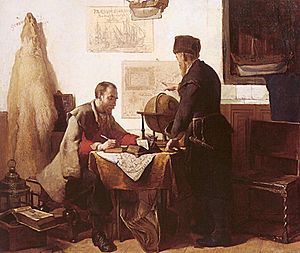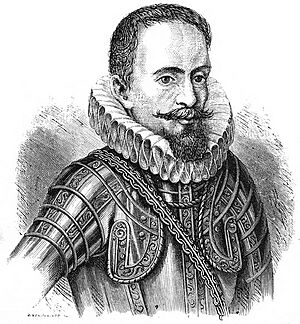Jacob van Heemskerck facts for kids
Jacob van Heemskerck (born March 3, 1567 – died April 25, 1607) was a brave Dutch explorer and admiral. He was known for his daring spirit and important voyages across the world's oceans.
Contents
Early Life
Jacob van Heemskerck was born in Amsterdam, a big city in the Netherlands, in 1567. People described him as having a gentle look, with large brown eyes and fair hair. Even though he seemed quiet and dressed simply, he was very daring. He had a strong desire to become famous in the navy and military.
Career
Exploring the Arctic

Jacob van Heemskerck first became famous for trying to find a new sea route. This route, called the Northeast Passage, would go from Europe all the way to China through the Arctic.
On May 10, 1596, two ships left Amsterdam. Van Heemskerck commanded one, and Jan Rijp commanded the other. A famous pilot named Willem Barents joined Heemskerck. Gerrit de Veer, who wrote about the journey, was also on board.
They sailed north, hoping to find a clear path in the open sea. On June 9, they discovered Bear Island in the Barents Sea. They kept going north and soon saw a huge, snow-covered land around 80° North. This land was blocked by thick polar ice. They named this important discovery Spitsbergen. At the time, they thought it was part of Greenland, but they were wrong.
On July 1, they returned to Bear Island. Rijp's ship went a different way, but Heemskerck and Barents continued east. They wanted to sail around the northern tip of Novaya Zemlya. On August 26, they reached a place they called Ice Haven. Here, their ship got stuck in the ice.
They had to spend the winter there. They built a house using wood from their ship. This was the first time anyone had successfully survived an Arctic winter. On June 13, they left in two small open boats. Sadly, Barents died on June 20 during the journey back to the Lapland coast. This amazing voyage helped start a successful whale and seal fishing industry for the Netherlands.
Journeys to the East Indies
After his Arctic adventures, Heemskerck led several trips to the East Indies. These were islands far away where valuable spices and goods came from. He helped set up trading posts there.
On May 1, 1598, Van Heemskerck left with a fleet of eight ships heading east. He returned home on May 19, 1600. The next year, he sailed again with a large fleet of thirteen ships. This time, he was with Admiral Wolphert Harmensz. Their fleet split up near the Azores. Harmensz went to Mauritius, while Van Heemskerck sailed directly to the Moluccas, famous for spices.
People said Van Heemskerck was not just a rough sailor. He was more like a gentleman adventurer, proud but also very brave. He knew how to make his sailors trust him completely. When Van Heemskerck was on board, the sailors felt safe. They even called a battle a "Heemskerck fight."
The Battle of Gibraltar
Later in his career, Van Heemskerck became a vice admiral. He helped protect Dutch merchant ships traveling to China and the Dutch East Indies. He took part in the Second Dutch Expedition to Indonesia.
Jacob van Heemskerck died during the Battle of Gibraltar on April 25, 1607. He was hit in the leg by a cannonball. In this battle, a Spanish fleet of 21 ships was completely destroyed by the Dutch.
His body was brought back to Amsterdam. He was buried with great honors in the Old Church. You can still see his suit of armor in the Rijksmuseum in Amsterdam. It is missing a thigh plate, which was shattered by the cannonball that caused his death.
See also
 In Spanish: Jacob van Heemskerk para niños
In Spanish: Jacob van Heemskerk para niños


